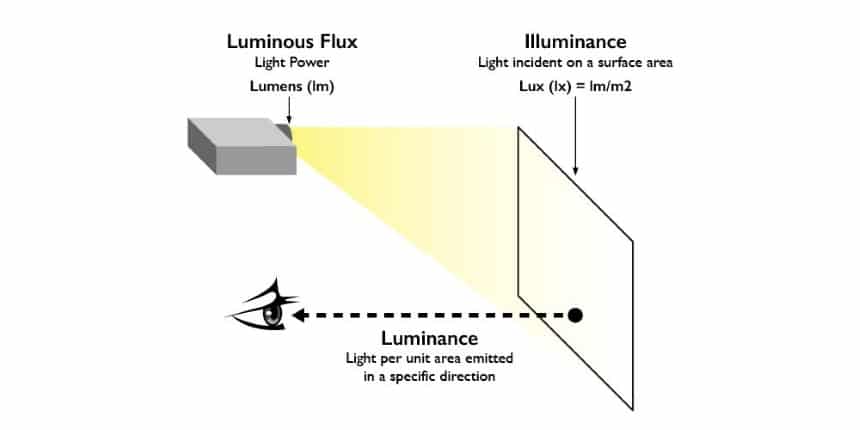As consumers are getting more and more sophisticated, it is essential that every product is described in detail. Their features, what they can do, and what they cannot do should be stated in order to avoid confusion.
Speaking of confusion, the lux vs. lumen projector is a concept that needs to be talked about. Lux and lumens are commonly used by marketers while promoting projectors. Some of them confuse one for the other, thereby leaving consumers helpless. Lux and lumens are terms that are used to measure how bright a projector is, but as much as they are similar, they are also different.
So, in this article, we’ll be explaining to you what lux means, what lumens means, and the difference between the two. But before that, let’s see the possible ways of measuring the brightness of a projector.

In this article, we’ll be focusing on the three widely and commonly used terms – lux, lumens, and ANSI lumens.
Brightness in photometry Trusted Source Photometry (optics) - Wikipedia en.m.wikipedia.org refers to the light you get directly from a source and reflected light, like the light the screen you’re reading from right now is emitting.
Your projector brightness determines the clarity of images you’ll get.
Lux is a unit of brightness that is measured in terms of surface area i.e., how much light reflects on a surface. It indicates how a human eye perceives light intensity by measuring how much incident light illuminates a surface.
Lux measures how bright a light appears after taking into account how it travels over an area. When you are close to your projector, the lux will be high, but when you are far away, the lux will be low. It has to do with distance.
However, distance won’t be a problem for people who have limited space in their homes, offices, or schools as they will get crisp visuals. For people with limited space, it’s best to make use of short throw projectors. These projectors will regulate the intensity of the light and give a fantastic view.
When you turn on your projector and reflect any content onto your screen, the amount of light visible to your eye is measured in lumens. It includes all the light the projector produces to make more vivid images.
To better understand lumens, you must understand luminous flux, which is the total amount of light emitted by a source per unit time. It’s also important that you don’t mix the meaning with radiant flux. While luminous flux is only used to describe the electromagnetic waves that can be seen with the naked eye, radiant flux measures electromagnetic waves from all sources, both the one that can be seen and the one that cannot be seen.
It is worth noting that you can’t judge the brightness of a projector with its lumens alone. The projector’s lumens only indicate how bright the light source is. It doesn’t put into consideration the actual lux (actual intensity of the light you will get).
No, ANSI lumens are not the same as regular lumens. ANSI lumens use more variables in their calculations making them more accurate. With ANSI lumens, you will understand how to read the power of a particular projector better.
The American National Standards Institute (ANSI) defined ANSI lumens as a unit for measuring the overall amount of light output by a projector; in other words, the greater the projector’s lumens, the brighter the light it generates and the lower the projector’s lumens, the dimmer the light it produces.
How bright your projector would be is dependent on what you want to use it for. The brighter your projector, the more lumens you’ll need. With even the cheapest 4K projectors, you can still get quality brightness as they have many lumens. In fact, these projectors are the dominant standard type of projectors used in digital cinematography, tv, and consumer media.
So, to determine how bright you want your projector to be, you have to consider the lumens. These three factors – content to be displayed, resolution, and ambient light must be examined to know your preferred number of lumens. The video below explains it in more detail.
To get optimum brightness, experts have recommended the use of EPSON Home Cinema for indoor use and GXX G1 Projector for outdoor movies.
To begin with, lux and lumens are both SI units used in measuring projectors’ brightness. They both quantify projectors’ brightness, but in two different ways. The quantity of light dispersed across a certain area is measured in lux, while the amount of light emitted from a source, taking account of human sensitivity, is measured in lumens.
The lumen is the quantity of light emitted from a light source, adjusted for the sensitivity of the human eye. Lux measures how bright a light appears after taking into account how it travels across an area. When it comes to projectors, 1 lux means 1 lumen per square meter.
When measuring lux and lumens from a fixed source, the lux will decrease with distance as the lumen will remain constant.
When purchasing a projector, the lumens should be considered first. The dispersion of an area’s effect on luminous flux must be taken into consideration. If the manufacturer or merchant does not display them but displays only lux, it’s a red flag that you need to be concerned about.
However, these two brightness measurements are critical when you’re on the lookout for a projector. With the knowledge of these two light units, you’ll be able to purchase a projector that will provide adequate light for a crisp image regardless of the distance.
With your new knowledge about lux vs. lumens projector, we are sure that you can now make the best choice amongst the projectors on the market. Brightness determines how enjoyable your viewing experience will be, so it’s important that you incorporate the knowledge gained while going through projectors’ features.
Projector’s brightness units, lux and lumens, are similar in the sense that they’re both used to measure brightness. But they are also different as lux refers to the light that reflects on a surface and lumens means emitted light that takes into consideration human eye sensitivity. Lumens are very important in terms of light production.





